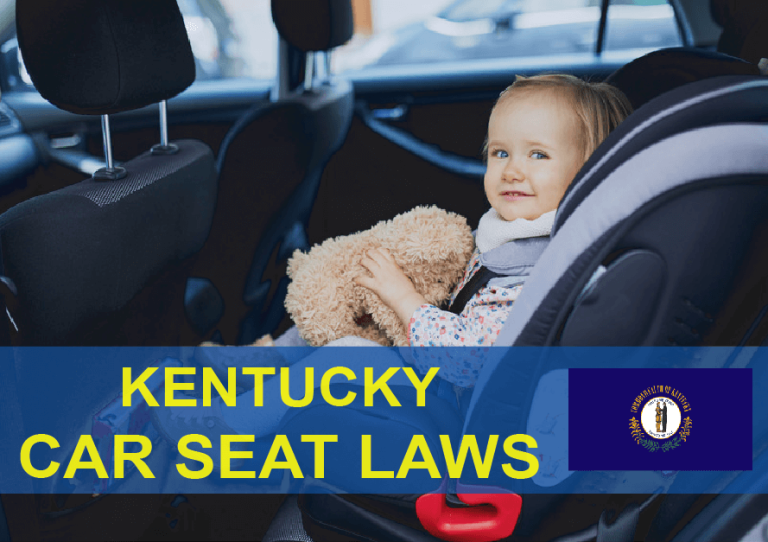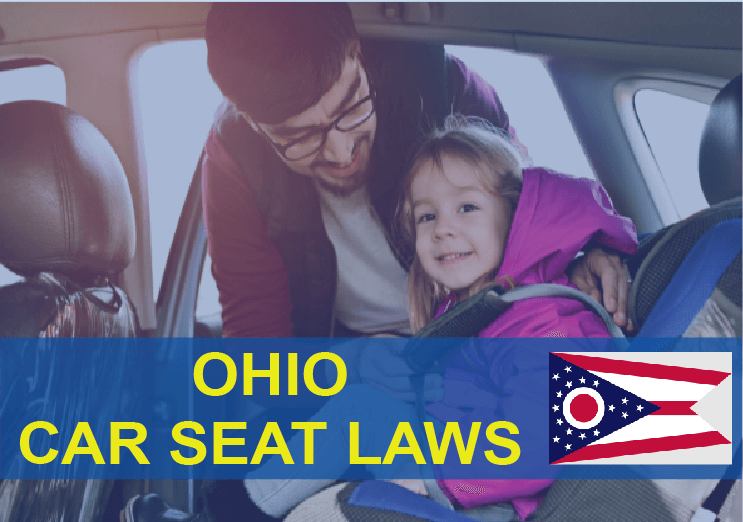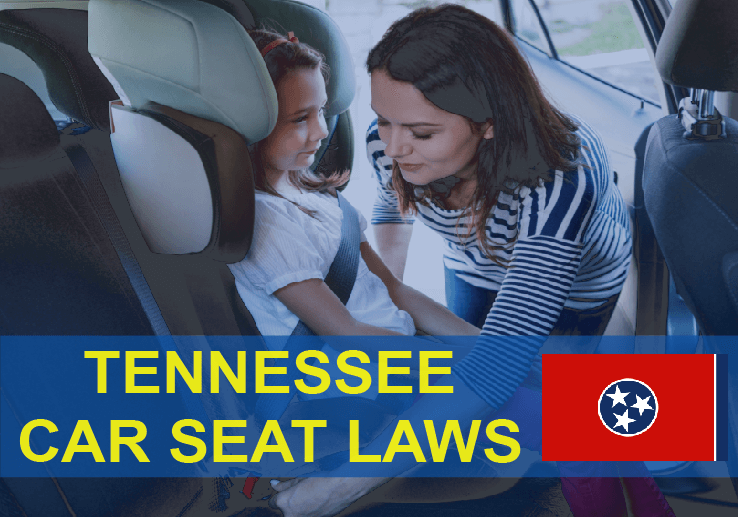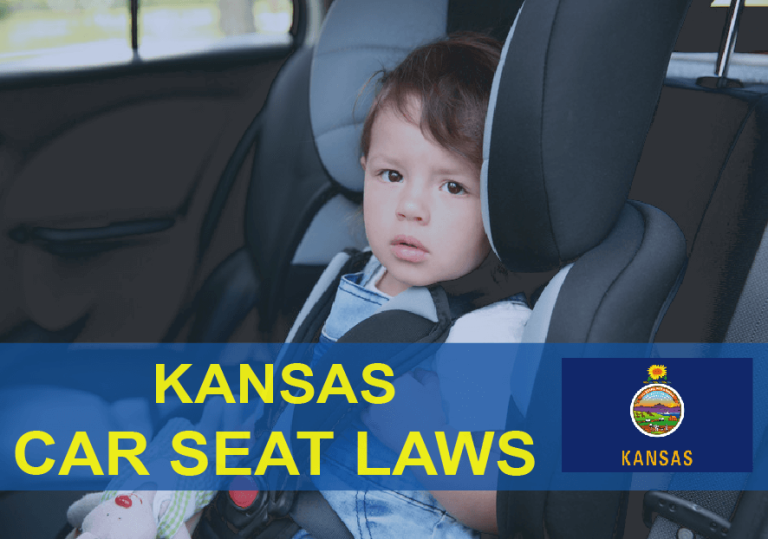Car seat laws in Oregon are among the state’s most important laws. The rising number of children and adults injured in car accidents each year has made it necessary for lawmakers to take action. This article will inform you about the Oregon car seat laws, what they require parents to do, and how they can help your child grow up safe and healthy.

- Oregon Car Seat Laws
- Oregon Infant/Toddler Car Seat Law
- Oregon Rear-facing Car Seat Law
- Oregon Forward-facing Car Seat Law
- Oregon booster seat law for young kids
- Requirements for children to use the front seat in Oregon
- Taxi Car Seat Law in Oregon
- Oregon car seat replacement law after Accident
- Law on leaving a child in a car in Oregon
- Penalties For Violating Oregon Car Seat Laws
- When Can My Child Sit in the Front Seat in Oregon?
- Is it Illegal to Smoke in a Car with a Child in Oregon?
- Car Seat Inspections Help in Oregon
- Child passenger safety related videos Oregon
- More information and resources on car seat safety Oregon
- USA Child Passenger Safety Laws by State
Oregon Car Seat Laws
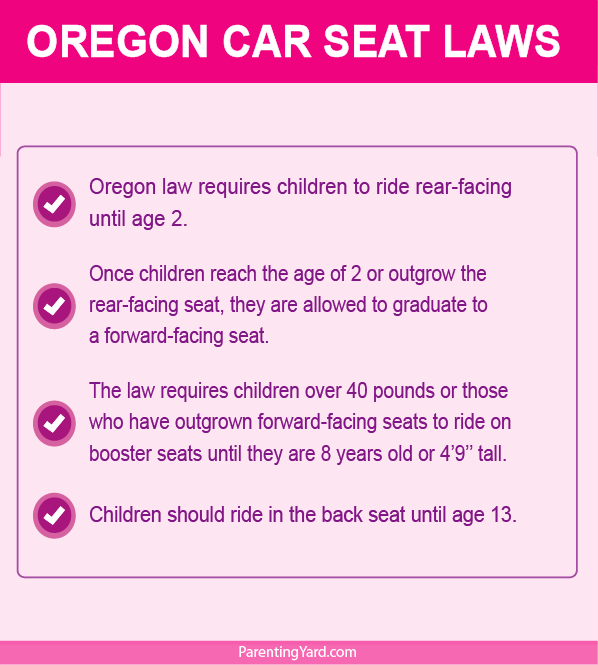
Oregon Infant/Toddler Car Seat Law
Infants must travel in a rear-facing or infant-only seat until they are two years old or meet the seat manufacturer’s maximum weight limit.
Oregon Rear-facing Car Seat Law
Oregon law requires that children ride rear-facing until they reach the age of two. The AAP (American Academy of Pediatrics) recommends that children remain rear-facing as long as possible or until the manufacturer’s weight and height limits are exceeded. This is because the rear-facing position provides the best protection for children because the seat’s back absorbs the majority of the impact forces, protecting the child’s sensitive body parts (neck, spine, and head).
Oregon Forward-facing Car Seat Law
Children are allowed to graduate to a forward-facing seat with a harness once they reach the age of two or outgrow the rear-facing seat. Additionally, the law requires that children use this sort of seat until they reach a minimum weight of 40 pounds. Parents who have convertible seats can face forward, while those who do not can opt for a forward-facing only seat. Two shoulder straps, a crotch strap, and two hip straps should be included on a seat with a 5-point harness. Straps must fit snugly around the child’s body and be fastened according to the manufacturer’s recommendations.
Oregon booster seat law for young kids
When the child reaches 40 pounds and the forward-facing car seat’s maximum weight limit, it is time to use a booster seat. Do not rush the child’s transition to the booster seat. Continue to use the forward-facing position for as long as possible. Children must be restrained in a booster seat until they reach the height of 4’9″ or the age of 8 years.
There are 2 types of booster seats:
• High-back booster seats – If your car’s seat back is lower than your child’s ears, you have to use a high-back booster seat to protect your child’s head and neck.
• Backless booster seats – If your car’s seat back is higher than your child’s ears, you can use a backless booster seat.
Requirements for children to use the front seat in Oregon
There is no legal law in the state that prohibits certain children from riding in the front seat. However, when there is an active airbag, rear-facing seats should never be placed in the front seat, according to the state, since this would violate the state’s guideline on the proper use of a child safety seat. According to the American Academy of Pediatrics, children should ride in the back seat until they are 13 years old.
If you are confused about whether your child should use a booster seat or an adult seat belt only, this simple test will help you decide.
The Five-Step Seat Belt Fit Test:
- Is the child able to sit all of the way back against the auto seat?
- Are the child’s knees able to bend comfortably at the edge of the vehicle seat?
- Is the belt crossing over the shoulder between the neck and arm?
- Is the lap belt as low as possible, with the thighs?
- Is it possible for the child to remain in this position the whole journey?
If you answered “no” to any of these questions, your kid is not ready for an adult seat belt and still requires a booster seat to travel safely in the car. Boosters are popular with kids since they are more comfortable!
Taxi Car Seat Law in Oregon
In Oregon, taxis are exempt from child restraint regulations. However, this does not imply that cabs are safe, and you should take precautions to ensure your child’s safety.
Oregon car seat replacement law after Accident
The state has no law that covers car seat replacement. The National Highway Traffic Safety Administration recommends that car seats be replaced following a moderate or severe accident. Car seats typically have an expiration date (about six years), so make sure to check yours.
However, “NHTSA recommends that car seats be replaced following a moderate or severe crash in order to ensure a continued high level of crash protection for child passengers. Car seats do not automatically need to be replaced following a minor crash.”
Law on leaving a child in a car in Oregon
There is no law in Oregon that prohibits a parent from leaving a child unattended in a car. However, it is best not to leave your child alone in the car for any period of time.
Penalties For Violating Oregon Car Seat Laws
In Oregon, a violation of the state’s safety belt law is classified as a Class D traffic ticket. The standard monetary penalty is $115.00.
When Can My Child Sit in the Front Seat in Oregon?
The state doesn’t have a law that says certain kids can’t be in the front seat. When there is an airbag in the car, the state says that rear-facing seats should not be put in the front seat. This would break the state’s rules on how to use a child safety seat. In general, the back seat is a better place for kids to be. They should stay there until they’re 13.
Is it Illegal to Smoke in a Car with a Child in Oregon?
Yes, it is illegal in Oregon to smoke in a car with a minor under the age of 18.
Car Seat Inspections Help in Oregon
Child passenger safety related videos Oregon
How to Install Child Car Seats – Basics and Beyond
Rear-facing Car Seats for Babies: Safety Tips
The car seat safety check that could save your child’s life
Live Q&A: Safety tips for car seats and booster seats
More information and resources on car seat safety Oregon
- American Academy of Pediatrics Car Seat Recommendations
- American Automobile Association Car Seat Guide
- Bans on Smoking in Vehicles Carrying Children
- Booster Seat Guide
- Center for Disease Control and Prevention Child Passenger Safety
- Is it illegal to leave a child in the car?
- IUSM Best Practice Recommendations
- Motor Vehicle Occupant Safety from Safe Kids Oregon
- NHTSA Car Seat Recommendations
- NHTSA Recall List
- Oregon Child Occupant Protection Law
USA Child Passenger Safety Laws by State
FIND YOUR STATE’S CAR SEAT LAWS
Click on your state on the map below to see your state’s car seat law

